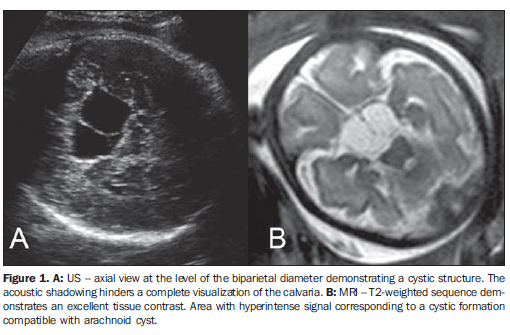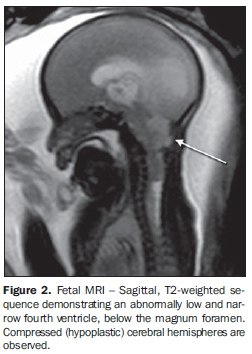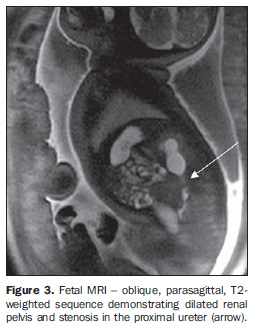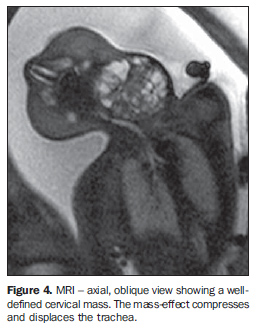Radiologia Brasileira - Publicação Científica Oficial do Colégio Brasileiro de Radiologia
AMB - Associação Médica Brasileira CNA - Comissão Nacional de Acreditação
 Vol. 41 nº 5 - Sep. / Oct. of 2008
Vol. 41 nº 5 - Sep. / Oct. of 2008
|
ORIGINAL ARTICLE
|
|
A critical review of benefits and limitations of magnetic resonance imaging as a complementary method in the diagnosis of fetal malformations |
|
|
Autho(rs): Renato Luis da Silveira Ximenes, Jacob Szejnfeld, Andréa Regina da Silveira Ximenes, Valdir Zanderigo |
|
|
Keywords: Fetal magnetic resonance imaging, Ultrasonography, Malformations, Single-shot, HASTE, Prenatal diagnosis |
|
|
Abstract:
IFellow PhD degree, Department of Imaging Diagnosis - Universidade Federal de São Paulo/Escola Paulista de Medicina (Unifesp/EPM), São Paulo, SP, Scientific Director for Centrus - Centro de Ultra-Sonografia e Medicina Fetal de Campinas, Campinas, SP, Brazil
INTRODUCTION The present study was aimed at evaluating a series of 40 fetuses with sonographic diagnosis of malformation by means of complementary magnetic resonance imaging (MRI) for determining the diagnostic benefits and limitations of this technique as compared with ultrasonography (US). Along the last four decades, US has been extensively utilized for assessing fetal malformations during the prenatal follow-up(1). In the obstetric practice, US is considered as an ideal diagnostic imaging method because of its non-invasiveness, relatively low cost, besides the advantage of not involving radiation exposure. On the other hand, this method presents some disadvantages related to the operator dependence, type of equipment, limited field of view, maternal obesity, oligohydramnios, fetal positioning and sonographic artifacts (for example: acoustic shadowing). The utilization of MRI for fetal evaluation was first described in 1983(2), and was initially utilized only in the evaluation of the placenta and maternal organs(3). At that time, fetal motion during images acquisition represented a major problem, so MRI was restricted to volumetric evaluations(4). Drugs such as muscular relaxants either indirectly(5) or directly (fetal cordocentesis) administered(6) were utilized in an attempt to induce fetal paralysis. Recent developments in MRI equipment have included the adoption of fast images acquisition protocols, so fetal motion artifacts are almost completely eliminated(7). These fast MRI techniques, known as single-shot fast spin echo and half-Fourier acquisition turbo spin-echo (HASTE) constitute a protocol whose images acquisition time is lower than one second(8). Ultrasonography is the primary screening method for the diagnosis of fetal abnormalities and also can be utilized as an adjuvant method in the assessment of fetal malformations during the prenatal follow-up.
MATERIALS AND METHODS Patients between 15 and 35 gestational weeks, previously diagnosed with fetal malformation, were evaluated by MRI. The protocol for the present study was previously approved by the Committee for Ethics in Research of the institution, and all the women signed a term of free and informed consent before being included in the study. Forty patients diagnosed with fetal malformation by US were included in the present study. Eight patients were excluded because of symptoms of discomfort and/or claustrophobia. Fetal anomalies were divided into subcategories, namely: central nervous system (60%), thorax (8%), abdomen (8%), renal system (10%), skeletal system (2%), fetal tumors (5%), twin gestations (2%) and syndromes (2%). All of the cases obligatorily underwent postnatal follow-up including evaluation in the delivery room, imaging studies and laboratory tests, and necropsy (in case of death), provided the procedure was authorized by the family. The analyses of the fetal MRI studies were reviewed by two radiologists with experience in fetal medicine. These cases were included in the study only after a complete analysis, systematic review of the US and fetal MRI images, and postnatal confirmation. The US studies were performed in a HDI 4000 equipment with a broad-band 4.0-7.0 MHz transducer (Philips; Bothel, USA) and Acuson Sequoia with multifrequency 3.5-5.0 MHz and 4.0-8.0 MHz transducers (Acuson; Mountain View, USA). Ultrasonography was adopted as the primary method for screening of fetal anomalies, and as a reference for indication of a complementary fetal MRI study. The sonographic diagnosis had occurred between 15 and 36 gestational weeks (mean = 28 weeks). A maximum 15-day interval was recorded between the US and the MRI studies. Two-dimensional (2D), three-dimensional (3D), B-mode, or even color-Doppler or harmonic ultrasonography in selected cases, were utilized. All the echographic studies were digitally stored, including all the sequences and planes (coronal, sagittal and axial). Fetal MRI studies were performed in a high-field 1.0 T Impact Magnetom System (Siemens Medical Systems; Iselin, USA) and 1.5 T Sonata System (Siemens Medical Systems; Iselin, USA), with a high-field body coil. The imaging protocols of the fetal MRI included T1- and T2-weighted sequences in the three orthogonal planes of the fetal body. The studies were started with sagittal, coronal and axial, T2-weighted sequences, utilizing each plane as a scanogram (scout) for the next imaging sequence. Most frequently, fetal MRI utilizes T2-weighted HASTE sequences(7), considering not only the excellent fetal tissues contrast provided by T2-weighted sequences, but also the high signal-noise ratio and relative insensitivity to susceptibility and motion artifacts. T2-weighted HASTE sequences provide excellent fetal tissues contrast, minimizing artifacts arising from fetal motion and maternal respiration(9). T1-weighted sequences are utilized for evaluating blood products and lesions with fat contents, with gradient refocused acquisition in the steady state (GRASS) and fast slow angle shot (FLASH). The quality of images acquired on T1-weighted sequences is a little more degraded because of the higher sensitivity to the fetal motion(10). The majority of studies in the literature suggest that MRI can be performed during the pregnancy(11-13). Worries are related to the maternal and fetal health. The care provided to pregnant women during examination is the same provided to the non-pregnant ones. Fetal concerns encompass teratogenesis and acoustic impairment. Maternal sedation and contrast agents were not utilized in the present study.
RESULTS The present study compared and correlated fetal MRI and US findings in the evaluation of fetal anomalies. The authors could observe that fetal MRI provided further information in 60% of the cases (24/40) (Chart 1). In cases of abnormalities in the central nervous system, fetal MRI provided further information in 16/24 (57%) of cases. The diagnostic benefits of fetal MRI in the assessment of the central nervous system were: a more detailed observation of the sulci formation, the myelination process, the subarachnoid space, the absence of bone artifacts, acquisition of images in the three planes, and a higher tissue and anatomical definition (Figure 1).
In cases of bifid spine, fetal MRI provided further information in the evaluation of the posterior fossa, including the degree of cerebellar herniation (downward herniation, compression and cerebellar hypoplasia) (Figure 2).
In the present study, three cases of fetal thoracic anomalies were evaluated. In the case of diaphragmatic hernia, fetal MRI provided further information in the identification of the liver positioning and content. In the case of upper airways obstruction, fetal MRI has not added information about the structures involved in the process/etiology of obstruction. Three cases of gastrointestinal tract abnormalities were evaluated, including a case of gastroschisis where fetal MRI did not provide further information. Four cases (10%) of genitourinary tract anomalies were evaluated. The following diagnostic benefits of MRI were observed: Non-contrast-enhanced identification of stenosis in the uretero-pelvic junction (Figure 3), and a good tissue resolution, even in cases of oligohydramnios, and diffuse sequences for evaluation of the renal function. Impossibility of early diagnosis of genitourinary tract abnormalities was a limitation of this method.
One case of skeletal alteration was evaluated by fetal MRI, but no additional information was observed in the evaluation of long bones. Extremities and joints movement could not be observed during the fetal MRI. Two cases of fetal tumor were evaluated. In the investigation of anterior cervical masses, the MRI diagnostic benefits were focused on the definition of the differential diagnosis. In the case of cervical teratoma, T2-weighted images can show high resolution and tissue contrast, thoroughly demonstrating the mass margins and texture (Figure 4). In the evaluation of sacrococcygeal tumor, the benefits of fetal MRI are related to the tumor size, extent, and involvement of adjacent structures(14). The limitation of this method in the evaluation of fetal tumors was the impossibility of demonstrating the vascular activity.
There was a case of monochorionic diamniotic twin gestation with echographic diagnosis of feto-fetal transfusion syndrome. Further information could not be obtained with fetal MRI. Fetal MRI and US images were compared, for evaluating the benefits and limitations of these methods in the prenatal diagnosis of fetal anatomic abnormalities. Chart 2 demonstrates US and fetal MRI limitations in the prenatal diagnosis of fetal malformations. The common positive quality of these methods is that both do not involve ionizing radiation exposure. Chart 3 demonstrates US and fetal MRI limitations in the prenatal diagnosis.
DISCUSSION Ultrasonography is the method of choice in the primary prenatal screening of fetal malformations because of its low operational cost and real-time capability. However, the authors could observe that fetal MRI can provide further information in cases of fetal malformation previously diagnosed by US. As the experience with fetal MRI progresses, an increasing number of other indications for complementary studies with MRI should be included. Studies demonstrate that fetal MRI can evaluate sequential changes in the central nervous system development, evaluate with higher accuracy ventricular walls and subarachnoid spaces, demonstrating particularly the organization of the intraparenchymal tissue because of the excellent contrast resolution on T-2-weighted sequences(15-17). In studies of the central nervous system, a limitation of the method is that the quality of images of the intracranial anatomy after the 20th gestational week is poor, possibly because of the size of the structures to be evaluated(18). Follow-up with fetal MRI in the third gestational trimester should be performed one or two weeks before delivery(19). There is a general consensus that MRI has become a safe and reliable method for evaluating fetal malformations(16). On the other hand, in the evaluation of the central nervous system, US presents limitations related to: artifacts produced by the calvaria and bones (posterior acoustic shadowing), gestational age, imaging planes and maternal obesity. Ultrasonography can evaluate the vascular flow of intracranial and cardiac structures during gestation, providing relevant information on the fetal hemodynamics. MRI advantages in the evaluation of fetuses with thoracic anomalies have been described by several studies in the literature(20). So far, fetal MRI benefits have not been observed in the evaluation of fetal cardiopathies. Fetal MRI might be useful in the evaluation of the signal intensity in lungs, considering that some studies have indicated a relationship between the signal intensity and the characterization of pulmonary hypoplasia(21). Lung volume calculation has shown to be a better marker than the signal analysis in the evaluation of pulmonary hypoplasia(22,23). In cases of congenital diaphragmatic hernias, the localization of the left hepatic lobe plays a relevant role in the determination of the perinatal prognosis because isolated "liver-up" and "liver-down" congenital diaphragmatic hernias are related to a perinatal mortality rate of respectively 57% and 7%(24). The protocol for evaluation of abdominal diseases by MRI varies according to the gestational age and the capability of the method of visualizing and differentiating the different abdominal organs which, by their turn, are dependent on the size of the structure that affects the typical corresponding signal depending on the sequence utilized. The knowledge about the normal fetal development is critical in the interpretation of fetal MRI images. While in adults, contrast-enhancement plays a significant role in the magnetic resonance images acquisition and interpretation, fetal MRI utilizes the amnionic fluid and, sometimes, the intestinal contents such as the meconium, as a "natural" contrast agent. Variations in the presence of this natural contrast media according to the gestational age result in different imaging findings. The small bowel can be identified on T1-weighted sequences with a hyperintense signal similar to that of the liver. Fetal MRI can identify the exact site of intestinal obstruction and also demonstrate multiple atresias(25). The following diagnostic benefits can be highlighted: in cases of anal atresia, where rectal filling and cloacal malformations can be identified with hypointense signal on T1-weighted sequences(26); cases of congenital megacolon (Hirschsprung disease), where the dilated rectum can be identified with a middle-intensity signal on T2-weighted sequences(27); and cases of adrenal diseases, where MRI can demonstrate the best differential diagnosis for neuroblastoma in cases of adrenal hemorrhage, subdiaphragmatic sequestration, renal cysts(28) and retroperitoneal lymphangioma(29). Diagnostic limitations in cases of abdominal and gastrointestinal anomalies occur in the early diagnosis of abdominal wall defects (< 18 gestational weeks), and intestinal motility. Ultrasonography is an excellent method for evaluating genitourinary tract anomalies, but the presence of maternal obesity and oligohydramnios may impair a thorough evaluation of the genitourinary tract(30). In the study of skeletal abnormalities, fetal MRI limitations are associated with the impossibility of studying the fetal motion, difficulty in the acquisition of images in appropriate planes for evaluating the skeleton, impossibility of 3D skeletal reconstruction (like that provided by computed tomography), and impossibility of evaluating the degree of calcification. Based on the analysis of the diagnostic benefits and limitations of both methods in the prenatal diagnosis of fetal abnormalities, one can conclude that, in selected cases, US should be complemented by fetal MRI. It is important to note that fetal motion still remains as a limiting factor, considering the low reproducibility of images acquisition in standard and symmetrical anatomical planes.
CONCLUSION The present study has comparatively evaluated US and MRI in the investigation of fetal malformations during the prenatal follow-up. Additionally, the authors defined the benefits and limitations of MRI as an adjuvant method in the fetal evaluation. Ultrasonography is a primary screening method, and fetal MRI provides additional information. It may be concluded that MRI can be utilized as a complementary method to US in the diagnosis of fetal malformations.
REFERENCES 1. Nicolaides KH, Snijders RJ, Gosden CM, et al. Ultrasonographically detectable markers of fetal chromosomal abnormalities. Lancet. 1992;340:704-7. [ ] 2. Smith FW, Adam AH, Phillips WD. NMR imaging in pregnancy. Lancet. 1983;1:61-2. [ ] 3. Smith FW. The potential use of nuclear magnetic resonance imaging in pregnancy. J Perinat Med. 1985;13:265-76. [ ] 4. Weinreb JC, Lowe TW, Santos-Ramos R, et al. Magnetic resonance imaging in obstetric diagnosis. Radiology. 1985;154:157-61. [ ] 5. Levine D, Barnes PD, Sher S, et al. Fetal fast MR imaging: reproducibility, technical quality, and conspicuity of anatomy. Radiology. 1998;206:549-54. [ ] 6. Seeds JW, Corke BC, Spielman FJ. Prevention of fetal movement during invasive procedures with pancuronium bromide. Am J Obstet Gynecol. 1986;155:818-9. [ ] 7. Levine D, Barnes PD, Edelman RR. Obstetric MR imaging. Radiology. 1999;211:609-17. [ ] 8. Levine D, Hatabu H, Gaa J, et al. Fetal anatomy revealed with fast MR sequences. AJR Am J Roentgenol. 1996;167:905-8. [ ] 9. Yamashita Y, Namimoto T, Abe Y, et al. MR imaging of the fetus by a HASTE sequence. AJR Am J Roentgenol. 1997;168:513-9. [ ] 10. Bradley WG Jr. MR appearance of hemorrhage in the brain. Radiology. 1993;189:15-26. [ ] 11. Formica D, Silvestri S. Biological effects of exposure to magnetic resonance imaging: an overview. Biomed Eng Online. 2004;3:11. [Acessado em: 3/10/2007]. Disponível em: http://www.biomedical-engineering-online.com/content/3/1/11 [ ] 12.Beers GJ. Biological effects of weak electromagnetic fields from 0 Hz to 200 MHz: a survey of the literature with special emphasis on possible magnetic resonance effects. Magn Reson Imaging. 1989;7:309-31. [ ] 13. Budinger TF. MR safety: past, present, and future from a historical perspective. Magn Reson Imaging Clin N Am. 1998;6:701-14. [ ] 14. Avni FE, Guibaud L, Robert Y, et al. MR imaging of fetal sacrococcygeal teratoma: diagnosis and assessment. AJR Am J Roentgenol. 2002; 178:179-83. [ ] 15. Lan LM, Yamashita Y, Tang Y, et al. Normal fetal brain development: MR imaging with a half-Fourier rapid acquisition with relaxation enhancement sequence. Radiology. 2000;215:205-10. [ ] 16. Levine D, Barnes PD, Robertson RR, et al. Fast MR imaging of fetal central nervous system abnormalities. Radiology. 2003;229:51-61. [ ] 17. Levine D, Trop I, Mehta TS, et al. MR imaging appearance of fetal cerebral ventricular morphology. Radiology. 2002;223:652-60. [ ] 18. Levine D, Barnes PD, Madsen JR, et al. Central nervous system abnormalities assessed with pre-natal magnetic resonance imaging. Obstet Gynecol. 1999;94:1011-9. [ ] 19. Robertson R, Caruso PA, Truwit CL, et al. Disorders of brain development. In: Atlas SW, editor. Magnetic resonance imaging of the brain and spine. 3rd ed. Philadelphia: Lippincot Williams & Wilkins; 2002. p. 279-370. [ ] 20. Levine D, Barnewolt CE, Mehta TS, et al. Fetal thoracic abnormalities: MR imaging. Radiology. 2003;228:379-88. [ ] 21. Ikeda K, Hokuto I, Tokieda K, et al. A congenital anterior diaphragmatic hernia with massive pericardial effusion requiring neither emergency pericardiocentesis nor operation. A case report and review of the literature. J Perinat Med. 2002;30:336-40. [ ] 22. Paek BW, Coakley FV, Lu Y, et al. Congenital diaphragmatic hernia: prenatal evaluation with MR lung volumetry - preliminary experience. Radiology. 2001;220:63-7. [ ] 23. Coakley FV, Lopoo JB, Lu Y, et al. Normal and hypoplastic fetal lungs: volumetric assessment with prenatal single-shot rapid acquisition with relaxation enhancement MR imaging. Radiology. 2000;216:107-11. [ ] 24. Leung JW, Coakley FV, Hricak H, et al. Prenatal MR imaging of congenital diaphragmatic hernia. AJR Am J Roentgenol. 2000;174:1607-12. [ ] 25. Benachi A, Sonigo P, Jouannic JM, et al. Determination of the anatomical location of an antenatal intestinal occlusion by magnetic resonance imaging. Ultrasound Obstet Gynecol. 2001;18:163-5. [ ] 26. Saguintaah M, Couture A, Veyrac C, et al. MRI of the fetal gastrointestinal tract. Pediatr Radiol. 2002;32:395-404. [ ] 27. Ohgiya Y, Gokan T, Hamamizu K, et al. Fast MRI in obstetric diagnoses. J Comput Assist Tomogr. 2001;25:190-200. [ ] 28. Aslan H, Ozseker B, Gul A. Prenatal sonographic and magnetic resonance imaging diagnosis of cystic neuroblastoma. Ultrasound Obstet Gynecol. 2004;24:693-4. [ ] 29. Houlihan C, Jampolsky M, Shilad A, et al. Pre-natal diagnosis of neuroblastoma with sonography and magnetic resonance imaging. J Ultrasound Med. 2004;23:547-50. [ ] 30. Levine D, Goldstein RB, Callen PW, et al. The effect of oligohydramnios on detection of fetal anomalies with sonography. AJR Am J Roentgenol. 1997;168:1609-11. [ ] Received September 24, 2007. Accepted after revision November 12, 2007. * Study developed in the Department of Imaging Diagnosis - Universidade Federal de São Paulo/Escola Paulista de Medicina (Unifesp/EPM), São Paulo, SP, at Cura - Diagnóstico e Imagem, São Paulo, SP, and at Centrus - Centro de Ultra-Sonografia e Medicina Fetal de Campinas, Campinas, SP, Brazil. |
|
Av. Paulista, 37 - 7° andar - Conj. 71 - CEP 01311-902 - São Paulo - SP - Brazil - Phone: (11) 3372-4544 - Fax: (11) 3372-4554




